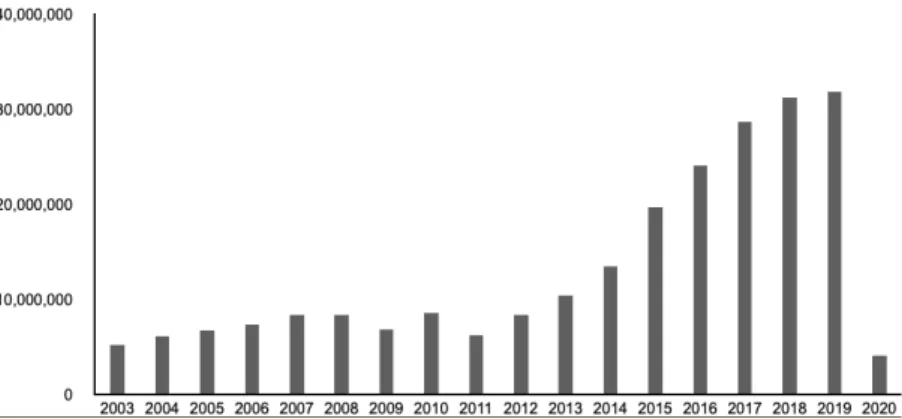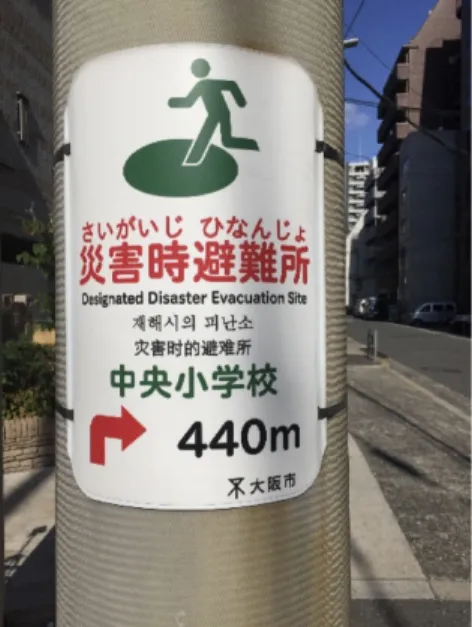Wakayama Tourism Review Vol. 1 (2021) 6
Introduction
Tourism has been seen as one of the key sectors for Japan’s future economic growth, especially since the early 2000s, and contributions by tourism to regional economies and revitalisation are widely ex pec ted . A s Fig u re 1 i nd ic ates, t he inbound tourism market has strongly expanded in the past decade. The number of international tourists exceeded 30 million in 2018, which is about six times more than in 2003, the year the national government launched a major inbound tou r i s m promot ion a l c a mpa i g n . A n additional increase was expected in 2020 with the Olympic and Paralympic games in Tokyo; however, due to the COVID-19 pandemic and the postponement of the games, the number of international tourists decreased by 87% in 2020 compared to the previous year (Japan National Tourism Organization, 2021).
The expansion of the inbound tourism m a r k e t h a s c o n t r i b u t e d t o J a p a n ’s economy both nationally and locally,
and the country has transformed into a major inbound tourism destination in Asia. However, it is undeniable that Japan has a high risk of exposure to a range of natural hazards, including earthquakes, tsunamis, typhoons, floods and volcanos. Japan was ranked fourth in the World Risk Index 2014’s list of natural hazard– exposed countries (Bündnis Entwicklung Hilft and UNU-EHS, 2014). It has been
acknowledged in the tourism literature that international tourists are often seen as vulnerable to natural disasters because of their unfamiliarity with the destination a nd because of t he la ng uage ba r r ier when tourists do not speak the language spoken at the visited destination (Pforr, 2009; Ritchie, 2008). This paper highlights the importance of taking this issue into consideration when discussing the future
International tourists as a vulnerable
group during natural disasters in Japan:
Their experience and local destinations’
new challenges
Hayato Nagai
Center for Tourism Research, Wakayama University, Japan Faculty of Tourism, Wakayama University, Japan
Figure 1. Changes in the number of international tourists in Japan Source: Japan National Tourism Organization (2021)
Note: The number for 2020 is a preliminary figure published in January 2021. Destinations, International tourists, Natural disaster, Pandemic
Keywords
Wakayama Tourism Review Vol. 1 (2021) 7
of Japan’s inbound tourism development t h roug h rev iew i ng t wo a r t icles t hat were published by the research team at Wakayama University’s Center for Tourism Research, with which the author of this paper is involved (i.e., Nagai, Ritchie, et al., 2020 and Nagai, Sano, et al., 2020). Although the two articles were written ba sed on t hei r resea rch pr ior to t he COVID-19 pandemic, the topic is relevant to the current tourism situation; thus, this paper also discusses the new challenges that local destinations are facing during the pandemic and will continue to face in the future.
Natural disasters in Japan
As noted, Japan is one of the countries with a significant exposure to a range of natural hazards. Nagai, Sano, et al. (2020) provided an overview of natural disasters in Japan with particular focus on catastrophic events that resulted in fata lit ies a nd missing persons during a 25-year period (1993–2017) by consulting secondary data available from government agencies. They reported that, based on the total number of fatalities, the Great Hanshin-Awaji earthquake in 1995 and the Great East Japan earthquake and tsunami in 2011 were the two worst disasters during the selected period: more than 25,000 people lost their lives or went missing due to these two events. However, other smaller-scale events, such as water-related events (e.g., storms, floods, and typhoons) and snow-related events (e.g., snowstorms and avalanches), also claimed the lives of more than 1,600 and 1200 people, respectively, and these smaller-scale events struck geographically diverse regions across the nation. Their article reconfirms the fact that the country experiences a wide range of natural hazards throughout the year.
International tourists’
preparedness and
experience
Nagai, Ritchie, et al. (2020) conducted in-depth interviews with 30 international tourists at Kansai International Airport, Osaka’s major international airport, in April 2018. They explored international tourists’ awareness of hazards in Japan a nd their ha za rd information sea rch behaviour before and during their trip. The study revealed that tourists were aware of natural hazards, especially earthquakes
and tsunamis; however, they generally perceived Japan as a safe country in which to travel. In fact, they did not expect to encounter these hazards during their trip. The study also identified tourists’ low involvement in hazard information search activities. The majorit y of the interviewees did not seek any hazard i n for mat ion a lt hough t hey were not familiar with actions they should take in case of a disaster in Japan. Figure 2 shows an example of a sign found in downtown Osaka that shows the nearest evacuation site in case of a disaster and provides directions to the site. The findings of Nagai, Ritchie, et al. (2020) imply that many tourists would not pay attention to this type of information while travelling in Japan.
Nagai, Ritchie, et al. (2020) interviewed tourists who were about to leave Japan and who had not experienced any natural disasters while in the country. Just two months after their interviews at Kansai International Airport, a 6.1-magnitude earthquake shook Osaka. No international t o u r i s t s l o s t t h e i r l i ve s , b u t a s t h e cit y is a major urba n dest inat ion for international tourists in the countr y, many tourists experienced this event during their holiday in Japan. To explore their experiences of the earthquake in Osaka, Nagai, Sano, et al. (2020) analysed blog entries posted by Chinese tourists who experienced the earthquake. Their a na lysis revea led t hat ma ny tourists faced difficulties in accessing accurate a nd updated informat ion in a t imely
manner. In particular, language barriers such as not understanding Japanese-language announcements at hotels at the time of the earthquake was a critical issue that increased their uncertainty. The Osaka earthquake highlights the fact that international tourists may be involved in future natural disasters in Japan, a country that experiences a range of natural hazards, and reaffirms the widely accepted notion that international tourists are vulnerable to natural hazards. This highlights the necessity of providing accurate and timely information by means that can overcome language barriers.
Local destinations’ new
challenges
During the pandemic, Japan continues to face a range of natural hazards. For exa mple, t he sout hern pa r t of Chiba prefecture was hit by heavy rain, and an evacuation advisory was issued to 552 households in the region on 13 April 2020, a week after the Japanese government declared a state of emergency for Tokyo and six other prefectures, including Chiba (The Nikkei, 2020). Evacuation centres in Kamogawa city, one of the municipalities in southern Chiba, implemented a range of measures including body temperature measurement, mask preparation, and social distancing to avoid creating the 3Cs (closed spaces, crowded places, and close-contact settings). Local municipalities across the country also had to reconsider t h e i r e x i s t i n g d i s a s t e r p r e v e n t i o n strategies, including how they manage evacuation centres in case of disaster. A lt hou g h t he pa ndem ic ha s pau s e d international mobility, tourism recovery a f t e r t h e p a n d e m i c i s e x p e c t e d . A s discussed earlier, tourism is expected to contribute to regional revitalisation a nd internationa l tourists have been encouraged to t ravel t hroughout t he country. However, it was revealed recently that only a small number of municipalities in the country have worked or are working on the development of evacuation manuals for international tourists in case of natural disaster (The Japan Times, 2020). As noted in Nagai, Sano, et al. (2020), providing effective communication to tourists during a disaster is essential so that they are well informed about the situation and can take appropriate actions. However, given the urgent and often sudden nature of
Figure 2. A sign showing directions to an evacuation site in Osaka
Wakayama Tourism Review Vol. 1 (2021) 8
these situations, providing accurate and timely information to tourists requires well developed coordination between authorities and industry stakeholders (Beirman, 2002). The pandemic has posed new challenges for local authorities in their future implementation of a disaster strateg y as, in addition to protecting tourists from natural hazards, preventing the spread of disease at evacuation sites needs to be taken into consideration.
Conclusion
This paper focused on natural disasters, an important and unavoidable topic when discussing the development of inbound
tourism in Japan. Through a review of two recent articles on this topic, international tourists’ preparedness and experience of natural hazards were discussed, and key issues that need to be considered for future tourism development were highlighted. New challenges that local destinations face during the pandemic and will continue to face in the future were also discussed. As with other countries in the world, the COVID-19 pandemic has significantly impacted the flow of international tourists to Japa n. It is hoped t hat t h is paper provides useful information to policy makers and industry practitioners in their development of a disaster strategy for tourists that can be implemented when
international tourism has recovered from the pandemic.
Dr. Hayato Nagai < hnagai@wakayama-u. ac.jp > is a Lecturer in the Faculty of Tourism at Wakayama University in Japan and a member of the Center for Tourism Research at the same university. He joined Wakayama University in 2016 after the completion of his PhD at the University of Queensland in Australia. His current research interests include tourism risk management, destination marketing and management and youth tourism market especially in the Asia-Pacific region.
Acknowledgement
This work was supported by the Japan Society for the Promotion of Science (JSPS) KAKENHI Grant Number JP17H02250.
References
Bündnis Entwicklung Hilft and UNU-EHS. (2014). World risk report 2014. https://i.unu.edu/media/ehs.unu. edu/news/4070/11895.pdf
Beirman, D. (2002). Marketing of tourism destinations during a prolonged crisis: Israel and the Middle East. Journal of Vacation Marketing, 8(2), 167-176. https://doi.org/10.1177/135676670200800206
Japan National Tourism Organization. (2021). Number of inbound tourists. Japan National Tourism Organization. https://www.jnto.go.jp/jpn/statistics/since2003_visitor_arrivals.pdf
Nagai, H., Ritchie, B. W., Sano, K., & Yoshino, T. (2020). International tourists' knowledge of natural hazards. Annals of Tourism Research, 80, Article 102690. https://doi.org/10.1016/j.annals.2019.02.008 Nagai, H., Sano, K., Ritchie, B. W., & Yoshino, T. (2020). International tourists in Japan: Their increasing numbers and vulnerability to natural hazards. In R. Sharpley & K. Kato (Eds.), Tourism development in Japan: Themes, issues and challenges (pp. 239-256). Routledge.
Pforr, C. (2009). Crisis management in tourism: A review of the emergent literature. In C. Pforr & P. Hosie (Eds.), Crisis management in the tourism industry: Beating the odds? (pp. 37-52). Ashgate.
Ritchie, B. W. (2008). Tourism disaster planning and management: From response and recovery to reduction and readiness. Current Issues in Tourism, 11(4), 315-348. https://doi.org/10.1080/13683500802140372 The Japan Times. (2020, June 24). Only 11% of Japan's municipalities plan disaster evacuation manuals for foreign tourists. https://www.japantimes.co.jp
The Nikkei. (2020, April 14). Hinanjo 3 mitsu no kaihi kyumu [Evacuation centers need to avoid the 3Cs]. https://www.nikkei.com/

